
Tales from the Northwest Passage: Arctic ‘Bricolage’
I had spent the summer transiting the Northwest Passage, crewing on the 51-ft yellow wooden sailboat named Breskell. “C’est du bricolage,” said Olivier Huin, Breskell’s builder and captain, who used the term to describe his makeshift creation of a staysail pole. Bricolage (brē-kō-ˈläzh) as defined by the Merriam-Webster Dictionary, is the “construction achieved by using whatever comes to hand” and French in origin. This being a French boat, it was a French way of saying jury-rigged, jerry-built, or do-it-yourself. I loved it. I also recognized it as a common theme aboard Breskell. Allow me to elaborate.
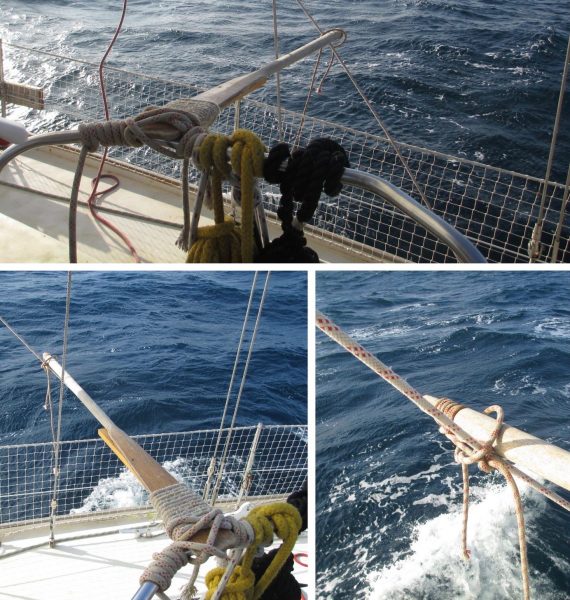
On the last leg of our journey, Breskell was sailing across the Northern Pacific from the Aleutians to Washington State. When I awoke for my watch, she was running downwind with a poled-out genoa and poled- out staysail. But I knew she had only one pole. Olivier had improvised another from a dinghy oar, using some scrap lumber and extra line. The blade end, with the addition of the lumber, was lashed to the mast pulpit. The lumber created a notch the metal bar could nest in. The opposite end captured the staysail sheet in a bowline, also lashed on, holding out the sail just enough to keep it filled. We successfully sailed with this double pole setup from the morning to the late afternoon, when the wind changed direction. The pole served its short-lived purpose well and was a clever use of marlinspike.
Breskell‘s electronic autopilot was not sorted out until after we had left Newfoundland, where we started the expedition. We had a TP32 Tillerpilot, but wheel steering. To adapt the instrument to the helm, we epoxied the tiller pin into a piece of light lumber and C-clamped this to the wheel. Later, in Greenland, we upgraded from the clamps by properly screwing the pin to the wheel. Due to the horizontal orientation of the tiller pin (intended to be vertical), we added a zip tie to keep the piston from popping off. Throughout the summer, the autopilot was impressive, steering through choppy seas and confused swells. It was the workhorse of the helm. Maintenance issues came up when the forces sheared off a screw and, later, the tiller pin. The screw was easy to replace, and there was still enough of the pin to re-epoxy back into the lumber.
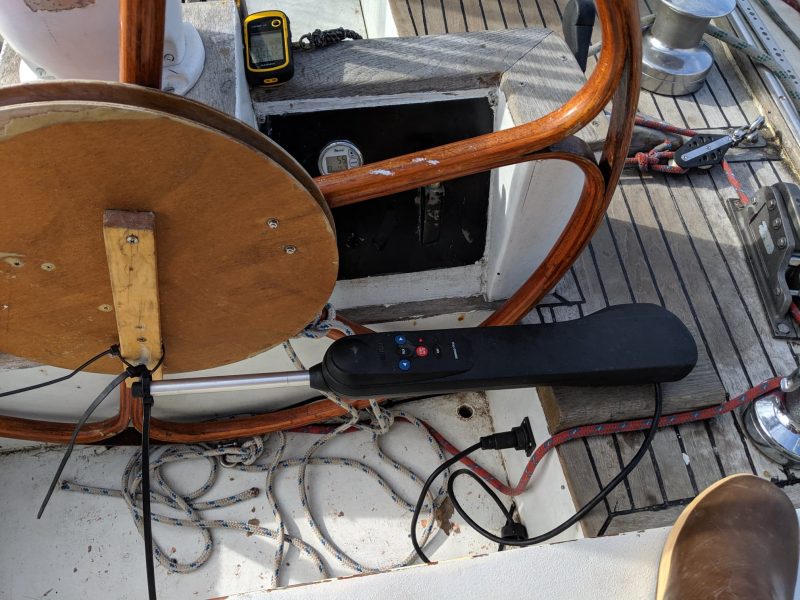
As the crew headed to and from the cockpit, we quickly learned that the shelf by the companionway was a natural go-to for hats, gloves, books, water bottles, and the like. We also learned that with the heeling and rolling, nothing was safe there. Gear would slide off, usually when we were asleep. A groggy-eyed search would ensue for “that second glove” before we went on deck. A simple solution proposed by crew member Eric worked like a charm, though it required some wine-drinking from Breskell’s crew. Since we were laid over in Greenland for a week, waiting for the ice to clear, we enlisted newfound friends to help too. Repurposed wine boxes and duct tape made for useful personalized bins. It turns out Eric is a seasoned wine box repurposer, with holdovers from a previous expedition amongst the boat’s drawers. Modifications were simple too. We fixed improperly spelled names and moved my box to the end, away from the hatch.
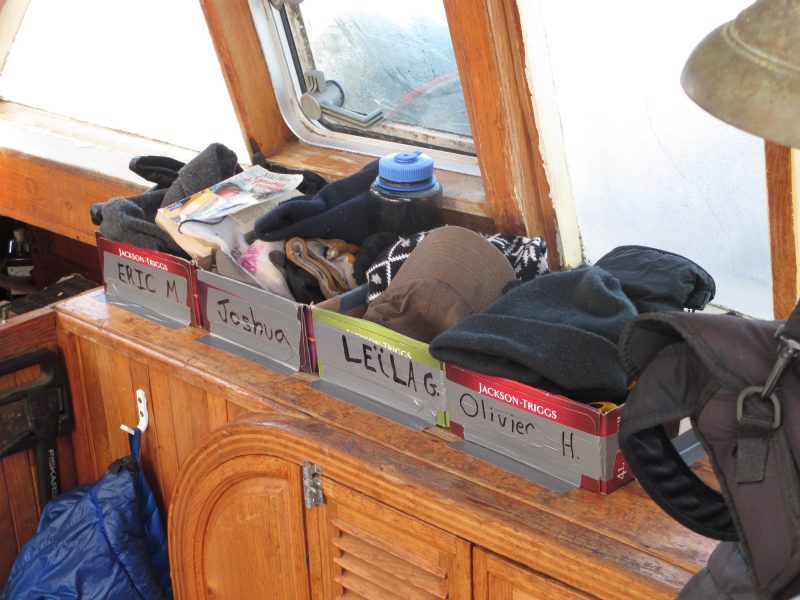
When you are away from port, or in places where supplies and options are limited, improvisation is the order of the day. A bit of bricolage is bound to enter your “deal with it” repertoire. Given enough time, even the most prepared sailors will succumb. Space, time, economic constraints, unforeseen circumstances, poor planning, or a seat-of-the-pants style will often inspire it or demand it. Bricolage won’t win you any “best in show” awards, but it may help get you from one ocean to another. The Resourceful Sailor hopes to shed light on the various ways to “make things work.”
Remember, keep your solutions prudent and safe, and have a blast.
An Old Latitude War Story
Back in the ’80s or ’90s, I went out on .38 Special, Latitude 38’s first Bertram 25 photo boat, to shoot a race that used the Yellow Bluff buoy as a mark. As I knew the fleet would be pounding up there soon — doubtless to provide some dramatic photos — I headed there directly from our Sausalito berth.
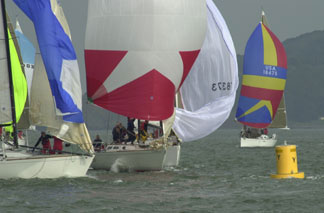
But as I got closer, it became obvious that Yellow Bluff wasn’t there. It was fairly common back then for marks to break free, and I thought it had happened again. But wait — what was that in the water up there? As I approached I thought it was a whale or something lounging on the surface. It was literally a bump in the water maybe two feet ‘proud’ of the surface. As I came closer and could look down into the water, I was surprised to see the Yellow Bluff buoy 2-3 feet under the surface, held there quivering by this massive ebb, which also produced the bump. Wow.
By this time, I could see the fleet coming toward me from the direction of Raccoon Strait. So I positioned myself landward of the buoy so as not to interfere with their wind or maneuvers as they rounded the mark. I recall seeing boats acting a bit erratically. I finally realized this was because they couldn’t see the submerged buoy either. Eventually, I think most recognized .38 Special — and headed for me.
The actual roundings were a bit of a Charlie Foxtrot as many boats misjudged the current and were swept past the mark. I got better pics later in the race.
A note from the Racing Editor: The Yellow Bluff buoy was not an aid to navigation maintained by the Coast Guard. Rather, the Yacht Racing Association placed it as a racing mark. The YRA eventually gave up on keeping a permanent buoy off Sausalito’s Yellow Bluff. The currents are too strong and the bottom too deep there. The buoys all eventually went walkabout. Now race committees set temporary inflatable marks in that vicinity.
Brickyard Cove Marina Has Slips to Rent
Beware the King Tides
King Tides
‘King Tides’ are coming to California on January 10-12 and February 8-9.
“Add in the runoff from winter rains and you will be walking up the gangway to your boat,” comments North Bay sailor Pat Broderick, a frequent contributor to Latitude 38. “Or wading across a low-lying parking lot. Or you can join a King Tide event. Hip boots optional.”
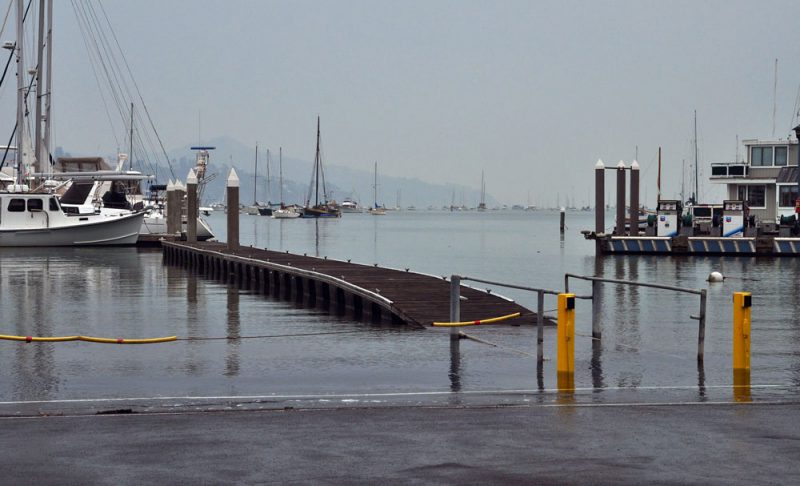
The California King Tides Project invites residents to “raise awareness about sea level rise and help communities plan for the future by taking and sharing photos of the highest high tides of the year. We need your help, and it’s easy to do:
- Find out what time the King Tides will be near you.
- Learn how to participate by uploading your photos via a web browser or app.
- Check out last year’s photos on our interactive map.
“During King Tides you can head out on your own, with friends and family, or join one of the organized events. As always, please be cautious and respect the power of the ocean. Learn more at california.kingtides.net.”
“Be aware that any standing water in a street in Sausalito or on Highway 101 is salty,” advises Pat. “If you don’t want your car to look like you live in Upstate New York or the Midwest, where they salt roads for ice, avoid the pools.”
If you encounter a dramatic king tide on January 10-12 at your marina or other waterfront location, snap a photo and send it off to us by email. The ‘Wolf Moon‘ will be full on January 10 — with a penumbral lunar eclipse.
‘King Tides’ aren’t exactly synonymous with ‘spring tides’. Read on to learn more.
Spring Tides
A while back, someone asked the Old Farmer’s Almanac, “Is a spring tide the same as a neap tide?”
“No,” replied the cognoscenti at the Almanac. “Spring tides usually occur twice a month at the new and full Moons, when the Sun and Moon are in a straight line with Earth. Neap tides usually occur twice a month as well, but at the first quarter and last quarter Moons, when Earth is at right angles to the Sun and Moon. Spring tides are lower- and higher-than-usual tides, whereas neap tides are in the moderate range.”
Sea Level
In the same section of that useful resource, we found a related question: “How is sea level determined? Is it the same for every sea?”
The almanac’s answer: “Sea level is determined halfway between high tide and low tide, as measured by a tide gauge. It is a relative, rather than an absolute, measurement and varies from ocean to ocean. It even varies from coast to coast on the same ocean. Sediment deposits at the mouths of rivers, natural and manmade erosion, and engineering projects can affect relative local sea level. Continental drift and global warming also may be factors. Sea level is the standard used to determine local land elevations and geographic features. Mean sea level is the average height of all the oceans and is used to determine the relative height of geographic features worldwide. According to most estimates, mean sea level has risen about four to eight inches over the past hundred years.”
A Brief Word About the Fires in Australia
In late December, as Australia’s largest city was choked with smoke from the devastating wildfires burning in the country’s interior, the Big Boat Challenge, a practice race for the Rolex Sydney Hobart, was canceled due to the poor air quality. The commodore of the Cruising Yacht Club of Australia told the New York Times, “We just don’t know what the wind is going to do. We’ve never had to plan for this before. While this race is important, there’s people losing their houses, and firefighters are putting themselves in danger. It would be great if the fires are all gone before the race.”
As Rolex Sydney Hobart started on Boxing Day (December 26), the fleet sailed away from the hazy, smoky murk clinging to the Australian continent.
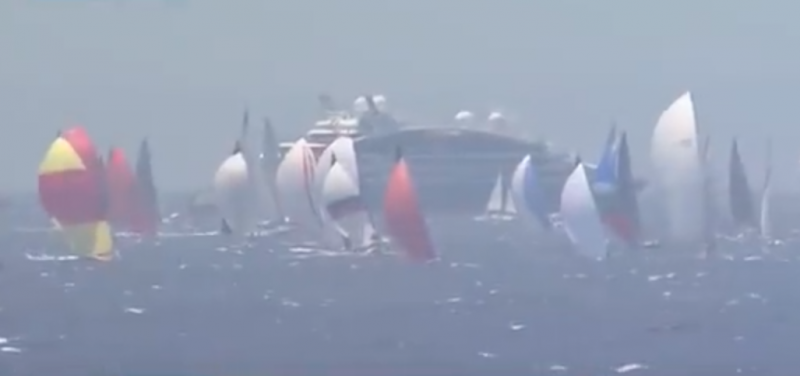
Sadly, the fires have only gotten worse, and while the infernos are largely inland, some coastal areas have been affected.
Last week, the Australian navy evacuated nearly 1,000 people — both tourists and residents — trapped in Mallacoota on the Victoria coast. An Australian Member of Parliament called it an “unprecedented mass relocation of civilians,” according to BBC News. “Some 4,000 residents and tourists fled to the beach on Monday night [December 30], when racing bushfires encircled the town.”
The unofficial death toll from the catastrophic, months-long fires — which have burned an area about twice the size of Maryland — rose to 25 Monday. The long-range forecast suggests there might be some relief on the horizon for Australia with rain on the country’s east coast.

